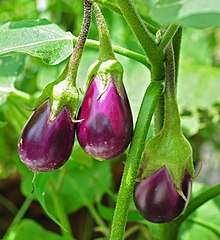Egg plant
| Eggplant | |
|---|---|
 |
|
| Scientific classification | |
| Kingdom: | Plantae |
| (unranked): | Angiosperms |
| (unranked): | Eudicots |
| (unranked): | Asterids |
| Order: | Solanales |
| Family: | Solanaceae |
| Genus: | Solanum |
| Species: | S. melongena |
| Binomial name | |
|
Solanum melongena L. |
|
| Synonyms | |
|
Solanum ovigerum Dunal |
|
| Nutritional value per 100 g (3.5 oz) | |
|---|---|
| Energy | 104 kJ (25 kcal) |
|
5.88 g
|
|
| Sugars | 3.53 g |
| Dietary fiber | 3 g |
|
0.18 g
|
|
|
0.98 g
|
|
| Vitamins | |
| Thiamine (B1) |
(3%)
0.039 mg |
| Riboflavin (B2) |
(3%)
0.037 mg |
| Niacin (B3) |
(4%)
0.649 mg |
| Pantothenic acid (B5) |
(6%)
0.281 mg |
| Vitamin B6 |
(6%)
0.084 mg |
| Folate (B9) |
(6%)
22 μg |
| Vitamin C |
(3%)
2.2 mg |
| Vitamin E |
(2%)
0.3 mg |
| Vitamin K |
(3%)
3.5 μg |
| Minerals | |
| Calcium |
(1%)
9 mg |
| Iron |
(2%)
0.23 mg |
| Magnesium |
(4%)
14 mg |
| Manganese |
(11%)
0.232 mg |
| Phosphorus |
(3%)
24 mg |
| Potassium |
(5%)
229 mg |
| Zinc |
(2%)
0.16 mg |
| Other constituents | |
| Water | 92 g |
|
|
|
|
|
| Percentages are roughly approximated using US recommendations for adults. Source: USDA Nutrient Database |
|
Solanum ovigerum Dunal
Solanum trongum Poir.
and see text
Eggplant (Solanum melongena), or aubergine, is a species of nightshade, grown for its edible fruit. Eggplant is the common name in North America, Australia and New Zealand, but British English uses the French word aubergine. It is known in South Asia and South Africa as brinjal.
The fruit is widely used in cooking. As a member of the genus Solanum, it is related to the tomato and the potato. It was originally domesticated from the wild nightshade species, the thorn or bitter apple, S. incanum, probably with two independent domestications, one in South Asia and one in East Asia.
The eggplant is a delicate, tropical perennial often cultivated as a tender or half-hardy annual in temperate climates. The stem is often spiny. The flower is white to purple, with a five-lobed corolla and yellow stamens. The egg-shaped, glossy, purple fruit has white flesh with a meaty texture. The cut surface of the flesh rapidly turns brown when the fruit is cut open.
It grows 40 to 150 cm (1.3 to 4.9 ft) tall, with large, coarsely lobed leaves that are 10 to 20 cm (3.9 to 7.9 in) long and 5 to 10 cm (2.0 to 3.9 in) broad. Semiwild types can grow much larger, to 225 cm (7.38 ft) with large leaves over 30 cm (12 in) long and 15 cm (5.9 in) broad. On wild plants, the fruit is less than 3 cm (1.2 in) in diameter, but much larger in cultivated forms: 30 cm (12 in) or more in length.
...
Wikipedia
